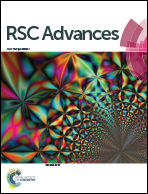Efficient inverted polymer solar cells employing an aqueous processing RbF cathode interfacial layer
Abstract
In this work, for the first time, thermal evaporated rubidium fluoride (RbF) and water-soluble RbF have been employed as the cathode interfacial layers (CILs) in inverted polymer solar cells (PSCs), respectively. The device with thermal evaporated RbF CIL exhibited a power conversion efficiency (PCE) of 6.41% when the thickness of RbF was 14 Å. A higher PCE of 6.82% was obtained in the aqueous RbF-based device, which is higher than that of a typical ZnO-CIL-based device (6.73%). More importantly, aqueous RbF opens a route to less poisonous, convenient, and low-cost processing CIL in inverted PSCs.


 Please wait while we load your content...
Please wait while we load your content...